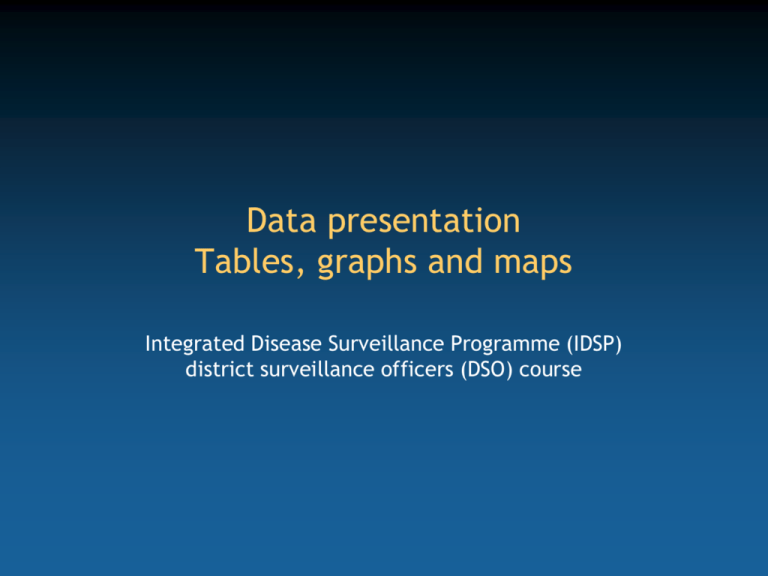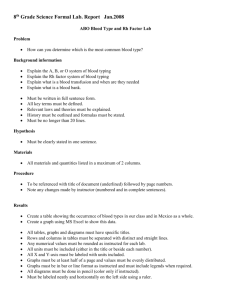Tables, Graphs and Maps
advertisement

Data presentation Tables, graphs and maps Integrated Disease Surveillance Programme (IDSP) district surveillance officers (DSO) course Outline of the session 1. 2. 3. 4. Analogical versus digital information Tables Graphs Maps 2 Communicating quantitative information • Analogical communication: Graphs Less precise More graphic Provides overall understanding • Digital communication: Tables Precise Numeric Provides detailed and exact description 7:00 am 3 Digital and analogical information Number of cases Cases of monkeypox by month of onset, Katako-Kombe, Zaire, 1996-1997 30 Example: Analogical display of information (Graph) 25 Secondary cases 20 Primary cases 15 10 5 0 Feb Mar Apr May Jun 1996 Jul Aug Sep Oct Nov Dec Jan Feb 1997 Month of onset WHO-CDC 4 Digital and analogical information Cases of Monkeypox by month of onset, Katako-Kombe, Zaire, 1996-1997 Feb-96 Mar-96 Apr-96 May-96 Jun-96 Jul-96 Aug-96 Sep-96 Oct-96 Nov-96 Dec-96 Jan-97 Feb-97 Total Primary cases 2 0 2 5 0 4 3 1 1 3 0 2 1 24 Example: Digital display of information (Table) 5 Secondary cases 0 3 2 6 5 9 23 5 2 1 0 0 9 65 Digital and analogical information Tables • Presentation of detailed analyzed data • Do not present raw data E.g., lists • Present analyzed data with summary statistics 6 Tables Typical table layout with components Title Column headings Data Row headings Footnotes 7 How to make sure that the cells of the table are understandable without referral to other material • Title Time, Place and Person information Any measurement found in all columns • Row and column headings Content of the row or column Any modifier applied to all cells of a row or column Unit of measurement (Abbreviations, if necessary) • Footnotes Clarify potential ambiguities Explain abbreviations, symbols, codes Note exclusions Mention data source 8 Tables Selected suggestions for data arrangement in tables 1. 2. 3. 4. Summarize rows and columns Compare numbers in columns Arrange key data by magnitude Align numbers by decimal 9 Tables 1. Summarize rows and columns Summarize rows and columns with totals, averages or other statistics Summary of the rows Year 1973 M 500 F 99 Both Sexes 600 1970 580 87 670 1968 1966 460 260 89 71 550 330 Mean 430 86 520 Summary of the columns 10 Tables 2. Compare numbers in columns Difficult to compare numbers in rows Compare numbers in columns 23 42 34 109 87 42 27 98 114 75 1st improvement: Right-justify numbers vertically 23 42 34 109 87 42 27 98 114 75 2nd improvement: Sort numbers 11 23 27 34 42 42 75 87 98 109 114 Tables 3. Arrange key data by magnitude Organize data by magnitude Exposure Cases (1000s) Rate A 11 B Exposure Cases (1000s) Rate 2.9 B 6 9.9 06 9.9 C 34 5.4 C 34 5.4 A 11 2.9 None 27 2.3 None 27 2.3 Which is the most important column you would use to sort the table? 12 Tables 4. Align numbers by decimal Align columns by decimal Keeping the zeros or not is a question of personal style 23 42 34 10.9 8.7 42 27 9.8 114 75 13 23.0 42.0 34.0 10.9 8.7 42.0 27.0 9.8 114.0 75.0 Tables Example of one way table: Data tabulated by one variable Age distribution of a sample of 100 villagers Age group (years) Number 0-4 19 5-14 25 15-44 40 45+ 16 Total 100 14 Tables Example of two way table: Data tabulated by two variable Age and sex distribution of a sample of 100 villagers Age group (years) Male Female Number 0-4 10 9 19 5-14 12 13 25 15-44 20 20 40 7 9 16 49 51 100 45+ Total 15 Tables Classical table of incidence by age and sex Incidence of cholera by age and sex, Kachua, West Bengal, India, 2004 Population Age group (years) Sex Total Incidence per thousand Cases 0-4 129 15 116 5-14 210 18 86 15-29 383 13 34 30-44 334 8 24 45-59 159 1 6 60+ 99 0 0 Male 666 28 42 Female 648 27 42 1,314 55 42 16 Use one graph to get one general idea across • • • • • • Don’t use a graph if there is nothing to say Frame the idea to communicate Identify the graph that matches this idea Eliminate unnecessary information If there are two ideas, use two graphs Add a title with time, place and person information 17 Graphs Proportion (%) Proportion of eligible patients whose blood slides were examined for malaria, Dhenkanal district, Orissa, 1996-2002 16 14 12 10 8 6 4 2 0 Is the graph useful? 1996 1997 1998 1999 2000 2001 2002 Years 18 Graphs Keep the ink-to-data ratio low • All elements on a graph must be justified • Eliminate distracting, non-essential elements Secondary axis Gridlines 3-D effects Bordering lines Etc… 19 Graphs Dracunculiasis rates, India, 1984-2000 (High ink to data ratio) 4000039792 35000 30000 30950 25000 23070 Number of cases20000 17031 15000 12023 10000 7881 5000 4798 20 2000 1998 1996 Year 1994 2185 1081 755371 60 9 0 0 0 0 1992 1990 1988 1986 1984 0 Graphs Dracunculiasis rates, India, 1984-2000 (Simpler, better, low ink-to-data ratio) 45000 40000 Number of cases 35000 30000 25000 20000 15000 10000 5000 0 1984 1985 1986 1987 1988 1989 1990 1991 1992 1993 1994 1995 1996 1997 1998 1999 2000 21 Year Graphs Choosing a type of graph 22 Graphs 0 2000 2001 2002 23 2003 May June July August September October November December 30 February March April May June July August September October November December January February March April May June July August September October November December January February March April 35 January February March April May June July August September October November December January February March April May June July August September October November December January Incidence of malaria per 10,000 Line graph for time series Malaria in Kurseong block, Darjeeling District, West Bengal, India, 2000-2004 45 40 Incidence of malaria Incidence of Pf malaria 25 20 15 10 5 2004 Months Graphs Histogram to display a frequency distribution • Graphic representation of the frequency distribution of a continuous variable • Rectangles drawn in such a way that their bases lie on a linear scale representing different intervals • Areas are proportional to the frequencies of the values within each of the intervals • No spaces between columns • No scale breaks • Equal class intervals • Epidemic curve is an example of histogram with time on the x axis 24 Graphs Histogram Urinary iodine excretion status, 24 N Parganas, West Bengal, India, 2004 Percentage 80 60 40 20 0 0-19.9 20-49.9 50-99.9 100-300 > 300 Urinary Iodine Excretion levels (µg/L) 25 Graphs Epidemic curve 90 80 70 60 50 40 May June July Week of onset 26 August 1st week 4th week 3rd week 2nd week 1st week 4th week 3rd week 2nd week 1st week 4th week 2nd week 1st week 4th week 3rd week 2nd week 10 0 3rd week 30 20 1st week Number of cases Acute hepatitis by week of onset in 3 villages, Bhimtal block, Uttaranchal, India, July 2005 September Graphs Proportions of a total presenting selected characteristics • Breakdown of a total in proportions: Pie chart • Breakdown of more than one total into proportion: Juxtaposed bar charts cumulated to 100% 27 Graphs Pie chart for the breakdown of a total in proportions Types of unintentional injuries, Tiruchirappalli, Tamil Nadu, India, 2003 Incidence: 9.6 per 100 person-month (95% C.I. 8-11 Minor injuries 35% Road 10% Fall 32% Burns 28 7% Bites 16% Graphs Cumulated bar chart for the breakdown of more than one total in proportions Proportion (%) Estimated and projected proportion of deaths due to non-communicable diseases, India, 1990-2010 100% 90% 80% 70% 60% 50% 40% 30% 20% 10% 0% Injuries Communicable diseases Non communicable diseases 1990 2000 Year 29 2010 Graphs Comparing proportions • No logical order: Horizontal bar chart Sort according to decreasing proportions • Logical order: Vertical bar chart 30 Graphs Horizontal bar chart Causes of non vaccination as reported by the mothers, Bubaneshwar, Orissa, India, 2003 Lack of awareness Child sick Irregularity by health staff Lack of motivation Lack of time Lack of facility Lack of money 0% India FETP 20% 40% 31 60% 80% 100% Graphs Vertical bar chart Prevalence of hypertension by age and sex, Aizawl, Mizoram, India, 2003 70 60 % 50 40 Male 30 Female 20 10 0 30-39 40-49 50-59 60-69 70 + Age group (years) 32 Graphs Maps • Use maps to display information by place Do not use tables! • Two types of maps: Spot maps Incidence maps • Use a key • Add a title with time, place and person information 33 Maps Drawing a spot map during an outbreak investigation • Rough sketch of the setting of an outbreak • One dot = One case • Other locations of potential importance are also recorded • Does not adjust for population density 34 Maps Spot map - Does not adjust for population density Cholera cases by residence, Kanchrapara, N-24 Parganas, West Bengal, India, 2004 35 Maps An incidence map adjusts for population density • List the cases • Regroup cases by location for which population denominator is available Look up census data • Divide the number of cases by the population denominator • Choose gradients of colours to represent increasing levels of prevalence 36 Maps Incidence map - Adjusts for population density Cholera attack rate and water supply, Sirunavalur, Tamil Nadu, India, 2002 Old well used only in the summer Attack rate by area 0-5% Reddiar street 5 –10 % PL street > 10 % Main road Water tank filled with well water Colony Main road Main road Centre east Muthuraja 37 Maps Preparing an incidence rate map: What you will need • • • • • • • A hardcopy of your map A transparency Cello tape Permanent markers Computer Drawing software Incidence by geographical area 38 Step 1: Place transparency on the hardcopy of map to draw map with permanent marker 39 Step 2: Stick the transparency on the screen with cello tape and follow the guide to draw map with the mouse in a drawing software 40 Step 3: Remove the transparency and edit the map in the drawing software 41 Step 4: Filling the map with data • Have a table of incidence by area • Rank the areas by increasing level of incidence • Sort the areas in four groups in which there is about the same number of area Add a fifth group if needed for incidence = 0 • Assign a colour per group • Draw the map 42 Rate of disease X by country, South East Asia WHO region, 200X Yearly incidence per 100,000 0 0-19 20-49 50-99 100+ Using colours in maps • The cold / warm scale Represents violent contrasts • Increasing density in one colour Represents increasing levels of magnitude • Complementary colours Use equivalent intensity Represents unrelated notions 44 Maps Take home messages 1. Choose whether you want to represent an overall message (Analogical) or whether you want to describe detailed data (digital) 2. Present analyzed data in tables with summary rows and columns 3. Display general ideas in graphs that carry one single message 4. Use maps to display information by place 45






